The Basic Anatomy of a Tree
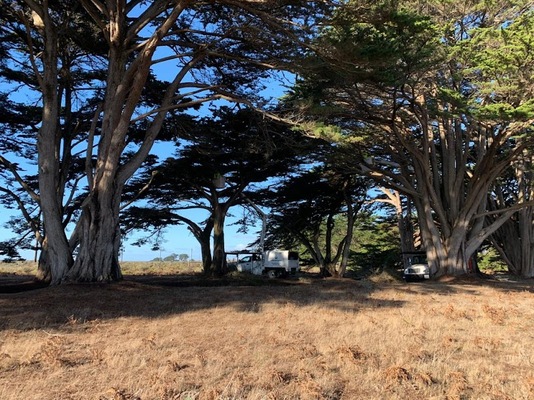
Introduction
Trees are among the most magnificent and vital organisms on our planet. While we all recognize what a tree is, there's no precise, universally accepted definition of a tree in everyday language or botany. In this comprehensive exploration of tree anatomy, we will delve into the fundamental components that make up a tree and its functions. We'll explore the various parts of a tree, from its trunk to its crown, and help you gain a deeper understanding of these magnificent structures.
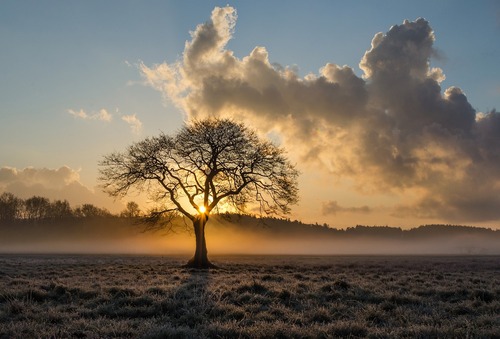
A Beautiful Lone Tree in Front of a Sunrise
Defining a Tree
In the broadest sense, a tree is any plant with an elongated trunk that supports branches and leaves above the ground. Trees are typically distinguished by their height, with shrubs being smaller plants ranging from eighteen inches to thirty-three feet. However, a more specific definition of a tree involves its primary growth being upward from the tip and the presence of a woody trunk formed by secondary growth, which thickens each year as it grows outward. Trees are also associated with specific uses as plants that yield lumber.
Components of a Standard Tree
A typical tree is composed of three main components: the trunk, the roots, and the crown. The trunk, or stem, is the main organ of the plant. It provides the tree with structural support, acting as a conduit for water and nutrients between the roots and crown. A tree may have a single trunk or multiple trunks.
Above-Ground Structure
- Bole: The section from the base of the trunk to the first branch.
- Trunk: The central structure from which branches grow.
- Branch: These typically extend horizontally or upward from the trunk, with large branches known as boughs and smaller ones as twigs. They support foliage growth.
- Foliage: A broad term encompassing leaves, including needles on pines and scale-like materials on junipers. The foliage is often green.
- Crown: The top of the tree.
Trunk and Branches
The trunk and branches provide trees with their distinctive permanence, setting them apart from other plants. The woody cores of trees make them resilient and long-lived, making their branches suitable for artistic pruning. The primary role of the trunk is to elevate the leaves above the ground, enabling them to capture sunlight and facilitate the transport of water, nutrients, and food between the roots and the rest of the tree.
Inside the Tree Trunk
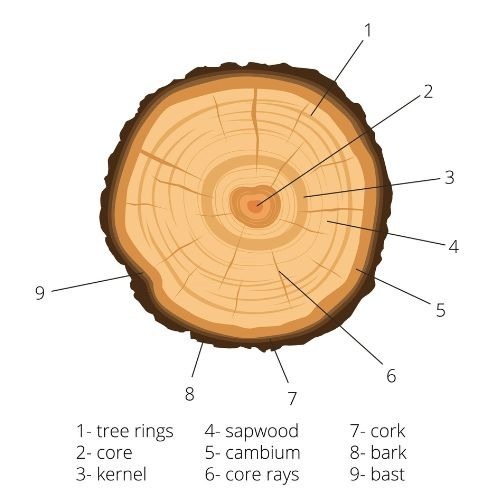
A Cross-Section Image of a Tree Trunk
When you cut across a tree trunk, you can observe various layers:
Pith:
The core of the trunk and the primary source of nourishment for the young plant. Pith, also known as medulla, constitutes a soft, porous tissue within the stems of vascular plants. It is comprised of delicate cells called parenchyma, which serve to store and convey nutrients.
Heartwood:
The densest, heaviest part of the trunk, often the darkest in color. The inactive xylem cells of the heartwood primarily provide strength and support to the tree. Moreover, the heartwood is essential in tree physiology, as it serves as a storehouse for sugars, dyes, and oils.
Sapwood:
Xylem, or sapwood, is the third layer of vascular tissue. It is made up of thick-walled cells that, like phloem, transport sap from the roots to the crown. The xylem represents the young wood of the tree and is light in color. As xylem cells age, they become inactive and turn into the tree's heartwood.
Cambium:
An outer growth layer that creates both sapwood and phloem, which, in turn, increases the tree's thickness. In climates with distinct seasons, the tree adds a new cambium layer each growing season. This expansion of the girth of the trunk (and branches) produces annual rings that can be interpreted by coring or felling to determine the tree's age.
Phloem (Inner Bark):
The next layer after the cambium tissue and before the bark. Its purpose is to move sap that has been transformed from leaf photosynthesis and contains sugar around the tree and back down to the roots.
Bark:
The protective outer layer whose characteristics vary from species to species. A tree's trunk and branches have a covering of bark. The bark derives from dead phloem cells, which are shed outward. It has multiple functions, including potential fire resistance, insulating the tree from excessive heat and cold, and providing protection against insects and diseases. Bark can range from very thin to up to 6 inches thick, as seen in the cork oak. It may have variable color and may contain tannins. The surface of the bark may range from smooth to deeply furrowed. Depending upon the species, dead bark can flake or peel off in patches or strips, which provides a key to tree identification and exhibits a distinctive appearance in the garden.
Growth Rings:
Each year of growth creates a new ring of sapwood that is visible.
Medullary Ray (Wood Ray):
Living cells that run across the growth rings, allowing the radial transportation of sap.
Roots
A complex root system exists beneath the ground, supporting a tree's growth and nutrition. Understanding the role of tree roots is essential for proper tree care.
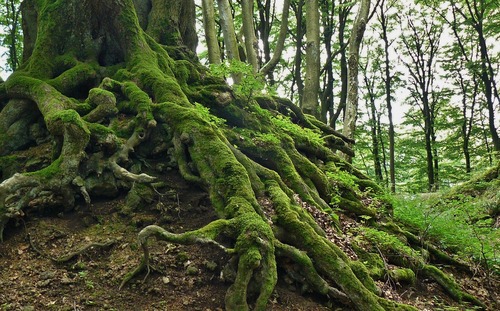
Exposed, Moss-Covered Tree Roots
The Functions of Tree Roots
Tree roots serve various critical functions:
- Uptake of water, oxygen, and minerals.
- Transportation of water and minerals toward the inner trunk.
- Structural support for the tree.
- Promotion of growth.
- Absorption of essential nutrients.
Large trees can have over thirty miles of roots, with millions of root tips and beneficial fungi aiding in the nutrient absorption process. The work of the root system is fueled by sugar from the leaves, using oxygen found between soil particles. One-celled projections, or root hairs, do the work of absorbing water and minerals from the soil. Beneficial fungi, called mycorrhizae, live on feeder roots and also contribute to the collection process.
Outgrowth of Roots
The length and depth of root growth depend on the available space. Without obstacles or disturbances, structurally supportive conducting roots can grow outward as far as two or more times the height of the tree. As they converge into laterally growing brace roots, these roots become thicker and provide much of the necessary additional support. Roots continue to grow in an ever-widening disk around the tree as needed, adapting to the surrounding environment.
Crown
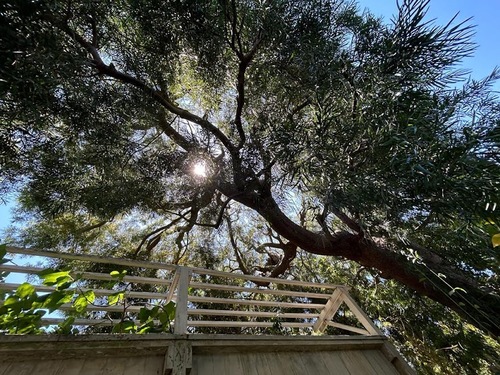
A View of the Sun from Beneath a Tall Tree
The crown, comprising the leaves and branches at the top of a tree, plays an important role in filtering dust and other particles from the air. It is a vital part of the tree, affecting both the tree itself and its surroundings.
Photosynthesis and the Role of Leaves
Leaves are vital for a tree's survival. They contain chlorophyll, a green pigment that facilitates photosynthesis, a process central to a tree's existence. Through photosynthesis, leaves use the sun's energy to convert carbon dioxide from the atmosphere and water from the soil into sugar and oxygen. This process fuels the tree's growth and sustenance. The sugar is either used immediately or stored in various parts of the tree, including the branches, trunk, and roots. The oxygen generated during photosynthesis is released into the atmosphere, contributing to the planet's oxygen levels.
Leaves come in a wide range of shapes and sizes, influenced by environmental pressures including climate and predation. Trees have evolved various leaf adaptations to optimize their exposure to light without shading each other. Leaves can be broad or needle-like, simple or compound, lobed or unlobed, smooth or hairy, delicate or tough, deciduous or evergreen. These adaptations ensure trees can thrive in diverse environments.
Resilience and Lifespan
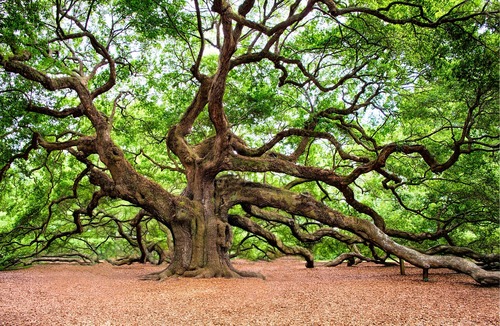
A Large, Ancient, Gnarled Tree
One of the most astonishing aspects of tree anatomy is its resilience and longevity. Trees with wood at their core can withstand various environmental stresses, making them capable of enduring for centuries. The presence of heartwood in the trunk provides structural support and stores essential substances, contributing to a tree's strength and durability. This longevity, coupled with the ability of trees to self-heal and adapt to changing conditions, highlights their vital role in the environment.
Environmental Benefits
Understanding the anatomy of trees is not just a matter of curiosity but is also vital for appreciating the numerous environmental benefits they offer. Trees play a crucial role in carbon sequestration. Their extensive root systems stabilize soil, preventing erosion and facilitating water filtration. Additionally, trees enhance air quality by absorbing pollutants and releasing oxygen. The shade provided by tree canopies reduces urban heat islands and conserves energy by cooling buildings in summer and providing windbreaks in winter.
Conclusion
Understanding the basic anatomy of trees is key to appreciating their beauty and significance in our ecosystem. Trees, with their roots, trunks, branches, and leaves, are marvels of nature that contribute to the well-being of our planet. As Albert Einstein once said, "Look deep into nature, and then you will understand everything better."
For expert tree care in Alameda, Hillsborough, and the Greater San Francisco Area, contact Arborist Now. We hope this comprehensive overview of tree anatomy has provided you with a deeper understanding of these magnificent natural structures and the crucial roles they play in our world. Trees are not just plants; they are intricate and awe-inspiring living organisms. Their resilience, longevity, and environmental benefits make them invaluable components of our planet's ecosystems and our everyday lives.
Originally posted on June 15, 2017





